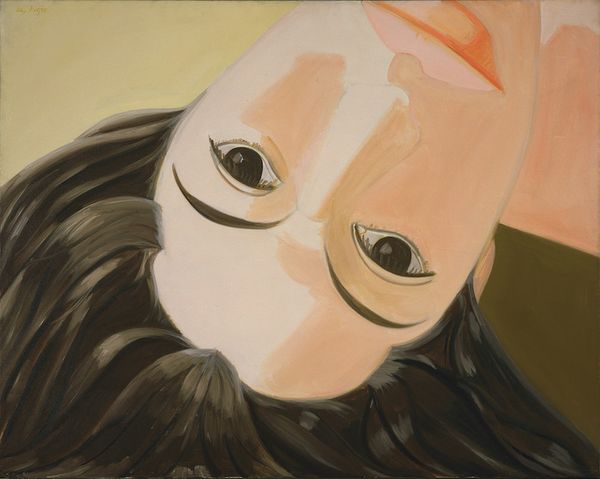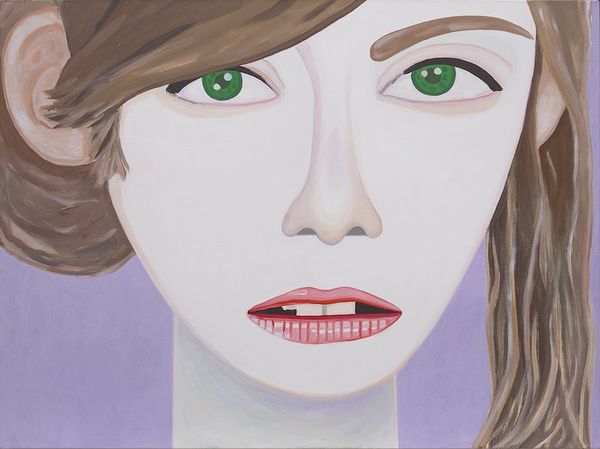Brian Calvin, Simple Twist, 2016. Estimate: £18,000 – 25,000. Wired: Online Auction.
Tightly cropped to fill the composition, the protagonist in Brian Calvin’s Simple Twist steals the viewer’s gaze, their cartoonishly large eyes, heart-shaped face, and slightly parted lips suspending us in a moment of contemplation. We study their emerald green irises, their arched eyebrow and the nape of their neck, all partially framed by a tender sweep of hair. Intensely personal, the portrait conveys the essence and soul of the figure, whose hair is half-styled in a “simple twist.”
Ambiguous, beautiful, and almost melancholic, Brian Calvin’s flat, cropped close-ups of feminine faces provide a quiet moment shared in the cinematic intensity of the figure’s face. For the last thirty years, the artist has become known for his non-narrative figurative paintings, which are not quite portraits, but rather portals to an idiosyncratic instant. The works incorporate the traditions of painting yet also verge towards an epic abstraction of the human form. As he has said, “I prefer to experience abstraction through the creation and tending of images. Painting provides the medium.”

Alex Katz, Upside Down Ada, 1965. Museum of Modern Art, New York . © 2020 Alex Katz. Licensed by VAGA at ARS, NY / DACS London. Image Scala Images, Florence.
Calvin has been variously compared to David Hockney and Alex Katz for his distinctly Californian approach, saturated color schemes, carefully disjointed compositions, and this hovering between formalism and representation. Like Alex Katz’s series of Ada portraits which spin a narrative around Katz’s muse, what is particularly unique about Calvin’s work is his isolation of characteristics, human features, and humans themselves in a way that both transcends time and is distinctly contemporary.
Calvin’s subjects (or “creatures,” as he calls them), although quite abstract, vaguely androgynous, and mostly anonymous, still possess personality and present femininity. Calvin gestures to individuality through subtle shifts in representation: a gap between front teeth, sunny highlights, plump lips clearly glossed with makeup. In Simple Twist, it is the hair that has fallen out of—or perhaps never made it into—the twist and hangs limply to the side like a stage curtain. She seems to be suspended between activities: her eyes a little wide, her utterly neutral mouth still mid-action.
I prefer to experience abstraction through the creation and tending of images. – Brian Calvin
In this way, Calvin abstracts time as well as form; one cannot place the subject’s emotions, identity, or narrative, in the same way that one cannot place the subject temporally. In Simple Twist, the subject is set against a faintly textured lilac background that plays with depth and shallowness, staging the frame in the same way Lucian Freud’s Girl with a Kitten, 1947 is positioned against a liminal and disorientating beige background.
In a 2016 discussion with Phillip Van den Bossche, Calvin shared that he liked “taking a history of figuration and then getting on the inside of it.” In Simple Twist, Calvin does just that—both questioning our reasoning for capturing a single moment and amplifying the meditative potential for doing so. Calvin’s subject expresses an attitude that strays from affectless to disaffected, depending on how long you look. It is the visual manifestation of the so-called “reflexivity trap” in which many young people find themselves today, a paralysis of being overly self-conscious in an image-saturated society. Calvin thus forces you towards “the inside” of the abstraction, wedging you into a moment of mindfulness.
In Simple Twist, the overriding observation is that, although the figure is frozen, the painting simply refuses to sit still. The more you look at the composition, the more ambiguous the shared moment becomes. Like a still within a film, the main character is bound with the viewer’s own projected reading of the captured moment; we are somehow more than onlookers, sharing our own deeply personal emotions with the protagonist.
Discover More from Wired: Online Auction >

Recommended Reading
Specialist Picks: Our Personal Favorites From 24/7 >
Hernan Bas and the Edge of Reality >
